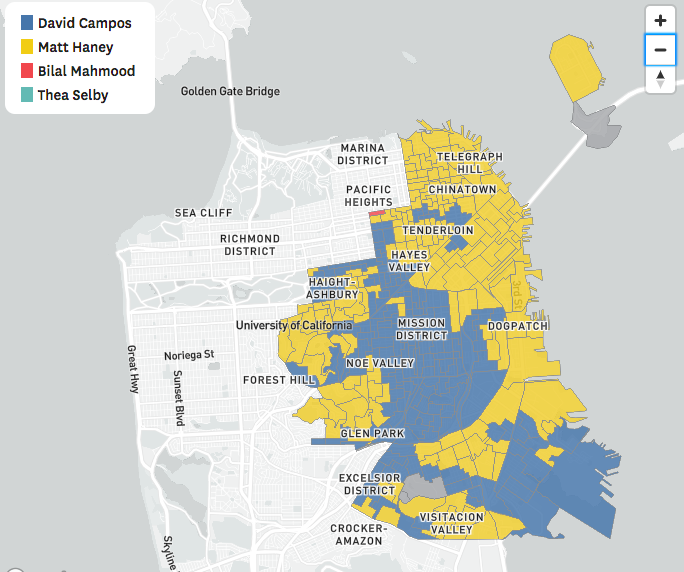It usually takes a day or two for someone in one of the campaigns to do the precinct breakdown—to figure out exactly how people voted on which issues in what parts of town. But the Chron has done us a favor and imported that data into an interactive map, which is easy to follow.
And it shows us some important patterns in Tuesday’s election results.

For starters, turnout was actually lower, often much lower, on the East Side of town, where the Assembly race was happening, than on the West Side, where the School Board recall was in effect the only thing on the ballot.
In some West Side precincts, data from the SF Department of Elections shows, turnout was as high as 40 percent—and as many of 90 percent of the voters supported the recalls. In other words: Those voters came out in large numbers just to vote for the recalls.
On the East Side, in many precincts turnout was as low as 18 percent, although it was higher in the northern areas like Chinatown, Telegraph Hill and North Beach. I don’t know how many of the voters in those higher-turnout areas were driven to the polls by the recalls (the numbers were in many areas upwards of 80 percent in favor) and voted in the Assembly race as a second thought.
If that’s the case, some of them might not turn out for the Assembly runoff April 19. Most of those would be Sup. Matt Haney and Bilal Mahmood voters.
Haney and David Campos both did well in their home districts, which is no surprise. Campos finished ahead in the Mission and the Castro—as well as Hunters Point. Haney won in Soma, Chinatown, North Beach, and Telegraph Hill, as well as parts of the Excelsior. Campos won in parts of the Tenderloin.
Beyond the base areas, in general, with some exceptions, Campos won in the neighborhoods that typically vote more progressive, and Haney won in the more moderate areas.
The Haight, typically one of the most progressive areas in town, was a mixed bag. Haney won in the typically more conservative upper Haight/Cole Valley area, but also in the area around Page and Broderick.
In some ways, Round One in the Assembly race was a Base Election. Both leading candidates made sure that they got enough voters they knew they could count on to get to the polls to make sure that they finished in the top two.
Now it gets interesting.
There are two classes of voters who will now matter: The ones who can still be persuaded, and the ones who have to be convinced to fill out their ballots.
There are probably areas in the Haight and the Excelsior and a few other areas where the campaigns can make inroads into each other’s voters. But it’s probably pretty limited. I think we can expect to see a huge barrage of negative ads attacking Campos, but the universe of voters that supported Campos in the first round and can be convinced to change their minds is very small.
The Mahmood voters are a critical mystery. We’re talking about 13,000 people, which could be the margin between victory and defeat in April. And I don’t think anyone knows who, if anyone, they will vote for in the next round.
The Mahmood voters could be convinced by those ads—if they turn out again. Both candidates will of course be trying to get his endorsement.
But the more important class of voters is the ones who have already made up their minds, or fall easily into one camp or the other, but might not bother to fill out a ballot. That, I suspect, is where this election will be decided.




